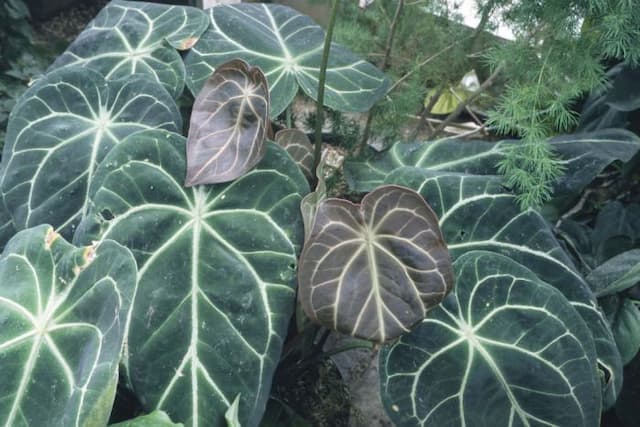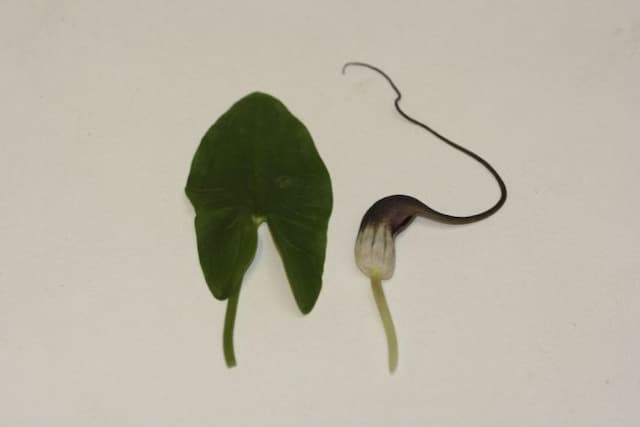Lords and Ladies Arum maculatum

ABOUT
The plant commonly known as lords-and-ladies is characterized by its distinctive foliage and inflorescence. It typically has broad, arrow-shaped, glossy leaves that may feature prominent spots. The leaves are deep green and can have a slightly wavy edge. The most striking feature of lords-and-ladies is its inflorescence, which consists of a hood-like structure called a spathe that can be purple, green, or white and wraps around a finger-like spike known as the spadix. The spathe often has a pale yellow hue at the edge and adds to the plant's exotic appearance. The spadix is a pale yellow and stands erect within the spathe. After flowering, the plant produces clusters of berries that are initially green and turn to a bright red at maturity. These berries are tightly packed together on the spadix, providing a sharp contrast to the surrounding greenery of the plant's leaves. Despite its alluring appearance, it's important to note that all parts of lords-and-ladies are toxic if ingested.
About this plant
 Names
NamesFamily
Araceae.
Synonyms
Lords-and-ladies, Cuckoo-pint, Jack-in-the-pulpit, Wild arum, Devils and Angels, Cows and Bulls, Adam and Eve, Starch-root, Bobbins, Naked boys, Wake robin, Friar's cowl, Sonsie-give-us-your-hand, Arons.
Common names
Arum maculatum var. immaculatum, Arum maculatum subsp. immaculatum, Arum immaculatum, Arum maculatum var. neglectum, Arum neglectum, Arum maculatum var. concolor, Arum maculatum var. viride, Arum maculatum var. kochii, Arum intermedium, Arum maculatum var. nanum, Arum maculatum var. integrum, Arum immaculatum var. vestitum, Arum festinans, Arum malyi, Arum pyrenaeum, Arum vulgare.
 Toxicity
ToxicityTo humans
The Lords-and-Ladies is toxic to humans if ingested. The plant contains calcium oxalate crystals, which can cause a burning sensation in the mouth, swelling of the lips, tongue, and throat, as well as difficulty swallowing. Symptoms may also include severe digestive upset, nausea, vomiting, and diarrhea. In severe cases, ingestion can lead to respiratory problems, kidney failure, or even death.
To pets
Lords-and-Ladies is also toxic to pets, with similar symptoms to those seen in human poisoning. If a pet consumes any part of the plant, they might experience oral irritation, intense burning and irritation of the mouth, tongue, and lips, excessive drooling, vomiting, and difficulty swallowing. In severe cases, this can progress to more serious symptoms such as respiratory difficulties or kidney failure.
 Characteristics
CharacteristicsLife cycle
Perennials
Foliage type
Deciduous
Color of leaves
Varies
Flower color
Green
Height
1-2 feet (30-60 cm)
Spread
1-2 feet (30-60 cm)
Plant type
Herb
Hardiness zones
5
Native area
Europe
Benefits
 General Benefits
General Benefits- Ornamental Appeal: Arum maculatum, commonly known as Lords-and-Ladies, is appreciated for its distinctive spadix and spathe, which add a unique aesthetic to gardens.
- Wildlife Attraction: The berries and flowers can attract various insects and birds, contributing to biodiversity.
- Shade Tolerant: Lords-and-Ladies can grow in shaded areas where other plants might struggle, making it suitable for woodland gardens.
- Educational Interest: Its interesting reproductive mechanism involving heat production and insect trapping is a subject of study and fascination.
- Cultural Significance: Has a place in folklore and was historically used in various traditions, which might be of interest for cultural education.
- Soil Improvement: Like many other plants, it can help to stabilize soil and prevent erosion.
 Medical Properties
Medical Properties- This plant is not used for medical purposes.
 Air-purifying Qualities
Air-purifying QualitiesThis plant is not specifically known for air purifying qualities.
 Other Uses
Other Uses- As a starch source: The root of Arum maculatum, commonly known as Lords-and-Ladies, can be processed to extract starch, traditionally used for stiffening linen.
- Insect trapping: The plant's inflorescence can generate heat, which helps to allure and trap insects, effectively functioning as a natural insect trap.
- Educational tool: Due to its unique pollination mechanism, Lords-and-Ladies is sometimes used in educational settings to demonstrate plant-insect interactions and the biology of pollination.
- Horticultural curiosity: The distinctive spadix and spathe of Lords-and-Ladies make it an interesting specimen for collectors of unusual garden plants.
- Traditional folklore: The plant has a rich history in folklore and has been used in various cultural rituals and superstitions, especially in Europe.
- Ink and dye: The berries of Lords-and-Ladies have been historically used to make a form of ink or dye, although it is not commonly practiced due to the plant's toxic nature.
- Floral displays: Despite its toxicity, the plant, particularly its bright red berries, is sometimes used in floral arrangements for its aesthetic appeal.
- Wildlife food source: Although toxic to humans, the berries can serve as a food source for certain birds and wildlife which are not affected by the plant's poisonous attributes.
- Biomimicry inspiration: The unique shape and structure of the Lords-and-Ladies may serve as inspiration for designs in biomimicry applications due to its clever pollination strategy.
- Craft material: The large, arrow-shaped leaves have been used in crafting, such as imprinting patterns in clay or being incorporated into nature-inspired art pieces.
Interesting Facts
 Feng Shui
Feng ShuiThe Lords and Ladies is not used in Feng Shui practice.
 Zodiac Sign Compitability
Zodiac Sign CompitabilityThe Lords and Ladies is not used in astrology practice.
 Plant Symbolism
Plant Symbolism- Invisibility - Arum maculatum, commonly known as Lords-and-Ladies, has been associated with the idea of being hidden or unnoticed, potentially because it often grows in shady or wooded areas where it can be easily overlooked.
- Deception - The plant's hood-like spathe can be seen as a symbol of concealment, hinting at themes of trickery or deceit. This may also relate to the way its spadix lures in insects for pollination.
- Fertility - As a plant that emerges in spring and has a phallic spadix, Lords-and-Ladies is often linked with fertility and the life force.
- Protection - Historically, Arum maculatum was sometimes considered a protective plant, possibly due to its toxic properties which can deter animals and humans alike from consumption.
 Water
WaterFor the Lords-and-Ladies, water the plant thoroughly, allowing the soil to become slightly dry between waterings. This species typically requires water once every week, but this might vary with indoor conditions and climate. Provide around 16 ounces of water for smaller pots and up to 2 gallons for larger ones every week during the growing season. In winter, reduce watering to every other week, ensuring that the soil does not remain waterlogged, which can cause root rot.
 Light
LightLords-and-Ladies thrive in partial shade to full shade. The ideal spot for this plant is one where it receives dappled sunlight or is completely shaded from the intense midday sun. It's important to avoid placing this plant in direct, bright sunlight as it can scorch the leaves.
 Temperature
TemperatureThe Lords-and-Ladies plant performs best in temperatures ranging from 60 to 75°F. It can survive minimum temperatures down to around 50°F but should be protected from frost. The plant is not tolerant of extreme heat, so avoid placing it in conditions where temperatures exceed 80°F.
 Pruning
PruningPrune Lords-and-Ladies to remove spent flowers or yellow leaves which can occur naturally. Pruning is best done after the plant has finished flowering, usually in late summer or autumn. Pruning too frequently or at the wrong time can hinder the plant's growth and flowering.
 Cleaning
CleaningAs needed
 Soil
SoilLords-and-ladies (Arum maculatum) thrive in a soil mix that is rich, moist, and well-draining with high organic matter content. A mix incorporating garden compost, leaf mold, and loam can be ideal. The soil pH should be slightly acidic to neutral, ranging between 5.5 and 7.5 for optimal growth.
 Repotting
RepottingLords-and-ladies (Arum maculatum) generally do not require frequent repotting and can be repotted every 2 to 3 years. They prefer to be slightly root-bound, so repotting should be done only when the plant has outgrown its current container.
 Humidity & Misting
Humidity & MistingLords-and-ladies (Arum maculatum) prefer a high humidity level, mimicking their native woodland habitat. They thrive best in environments where the humidity is consistently above 60%.
 Suitable locations
Suitable locationsIndoor
Place Lords-and-ladies in shaded, humid spots indoors.
Outdoor
Plant Lords-and-ladies in shade, moist soil outside.
Hardiness zone
Lords-and-ladies (Arum maculatum) are suitable for USDA zones 5-9.
 Life cycle
Life cycleCuckoo Pint (Arum maculatum) begins its life cycle as a dormant tuber, which germinates in late winter or early spring. The plant then produces a spathaceous inflorescence, consisting of a spadix wrapped by a spathe, usually appearing in April and May; this is followed by the emergence of large, arrow-shaped leaves. After pollination, typically by insects attracted to the spadix's heat and smell, the flowers develop into a spike of bright red berries by late summer. These berries are dispersed predominantly by birds, which eat them and excrete the seeds to new locations. The plant goes dormant in autumn, with the foliage dying back, and the tuber remains underground until the next spring. Each year, as the plant matures, the cycle repeats with the regrowth of the tuber, ensuring a perennial life cycle.
 Propogation
PropogationPropogation time
Spring-Early Summer
The most popular method of propagating Arum maculatum, commonly known as Lords-and-Ladies, is through division of the tubers. This is best done in late summer to early fall, after the foliage has died back. Gardeners should dig up the tubers carefully, gently separating them by hand to avoid damage. It's important to replant the divisions promptly at a depth of about 4 to 5 inches (10 to 12.7 centimeters), spacing them approximately 12 inches (30.48 centimeters) apart to allow enough room for growth. Water the newly planted tubers well to help establish them. This method ensures genetically identical clones of the parent plant and is relatively easy and reliable.









